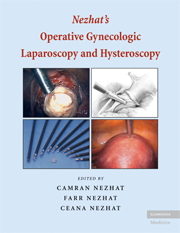Book contents
- Frontmatter
- Contents
- Contributing Authors
- Forewords
- Preface
- 1 HISTORY OF MODERN OPERATIVE LAPAROSCOPY
- 2 EQUIPMENT
- 3 ANESTHESIA
- 4 LAPAROSCOPIC ACCESS
- 5 LAPAROSCOPIC SUTURING
- 6 INTRAPERITONEAL AND RETROPERITONEAL ANATOMY
- 7 FERTILITY
- 8 HYSTEROSCOPY
- 9 MANAGEMENT OF ADNEXAL MASSES
- 10 ENDOMETRIOSIS
- 11 LAPAROSCOPIC ADHESIOLYSIS AND ADHESION PREVENTION
- 12 LEIOMYOMAS
- 13 HYSTERECTOMY
- 14 PELVIC FLOOR
- 15 LAPAROSCOPIC TREATMENT OF CHRONIC PELVIC PAIN
- 16 GYNECOLOGIC MALIGNANCY
- 17 LAPAROSCOPY IN THE PREGNANT PATIENT
- 18 MINIMAL ACCESS PEDIATRIC SURGERY
- 19 LAPAROSCOPIC VASCULAR SURGERY IN 2007
- 20 COMPLICATIONS IN LAPAROSCOPY
- 21 ADDITIONAL PROCEDURES FOR PELVIC SURGEONS
- 22 LAPAROSCOPY SIMULATORS FOR TRAINING BASIC SURGICAL SKILLS, TASKS, AND PROCEDURES
- 23 ROBOT-ASSISTED LAPAROSCOPY
- 24 HYSTEROSCOPY AND ENDOMETRIAL CANCER
- 25 OVERVIEW OF COMPLICATIONS
- Appendix
- Atlas
- Index
3 - ANESTHESIA
Published online by Cambridge University Press: 23 December 2009
- Frontmatter
- Contents
- Contributing Authors
- Forewords
- Preface
- 1 HISTORY OF MODERN OPERATIVE LAPAROSCOPY
- 2 EQUIPMENT
- 3 ANESTHESIA
- 4 LAPAROSCOPIC ACCESS
- 5 LAPAROSCOPIC SUTURING
- 6 INTRAPERITONEAL AND RETROPERITONEAL ANATOMY
- 7 FERTILITY
- 8 HYSTEROSCOPY
- 9 MANAGEMENT OF ADNEXAL MASSES
- 10 ENDOMETRIOSIS
- 11 LAPAROSCOPIC ADHESIOLYSIS AND ADHESION PREVENTION
- 12 LEIOMYOMAS
- 13 HYSTERECTOMY
- 14 PELVIC FLOOR
- 15 LAPAROSCOPIC TREATMENT OF CHRONIC PELVIC PAIN
- 16 GYNECOLOGIC MALIGNANCY
- 17 LAPAROSCOPY IN THE PREGNANT PATIENT
- 18 MINIMAL ACCESS PEDIATRIC SURGERY
- 19 LAPAROSCOPIC VASCULAR SURGERY IN 2007
- 20 COMPLICATIONS IN LAPAROSCOPY
- 21 ADDITIONAL PROCEDURES FOR PELVIC SURGEONS
- 22 LAPAROSCOPY SIMULATORS FOR TRAINING BASIC SURGICAL SKILLS, TASKS, AND PROCEDURES
- 23 ROBOT-ASSISTED LAPAROSCOPY
- 24 HYSTEROSCOPY AND ENDOMETRIAL CANCER
- 25 OVERVIEW OF COMPLICATIONS
- Appendix
- Atlas
- Index
Summary
Pneumoperitoneum and patient positioning during laparoscopy induce certain pathophysiologic changes. These must be understood for the anesthesiologist to provide the best perioperative care, particularly for patients with coexisting medical problems.
In this chapter, the changes induced by raised CO2 pneumoperitoneum and head-down tilt are reviewed. The complications of laparoscopy that are of immediate concern to the anesthesiologist are discussed, followed by a brief description of anesthetic techniques and postoperative management. Recent research involving anesthesia for nongynecologic laparoscopy is included when relevant.
HEMODYNAMIC CHANGES DURING LAPAROSCOPY
The hemodynamic effects of gynecologic laparoscopy are the result of raised intra-abdominal pressure, insufflation of CO2, and head-down positioning.
After CO2 insufflation to an intra-abdominal pressure greater than 10 mm Hg, cardiac output falls 10% to 30%, arterial pressure increases, and both systemic and pulmonary vascular resistance increase. Heart rate is unchanged. The fall in cardiac output is related to reduced flow in the inferior vena cava, pooling of blood in the legs, and an increase in venous resistance. Although venous return falls, cardiac filling pressures increase, which is consistent with the observed rise in intrathoracic pressure. There is an increase in intrathoracic blood volume. Systemic vascular resistance (SVR) increases because of an increase in the vascular resistance of intra-abdominal organs and increased venous resistance.
- Type
- Chapter
- Information
- Publisher: Cambridge University PressPrint publication year: 2008

